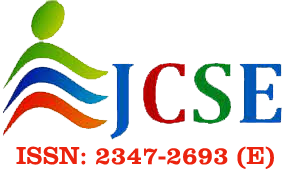BYOD with Multi-Factor Authentication
Surabhi Shukla1 , Neelam Joshi2
Section:Review Paper, Product Type: Journal Paper
Volume-3 ,
Issue-6 , Page no. 104-107, Jun-2015
Online published on Jun 29, 2015
Copyright © Surabhi Shukla , Neelam Joshi . This is an open access article distributed under the Creative Commons Attribution License, which permits unrestricted use, distribution, and reproduction in any medium, provided the original work is properly cited.
View this paper at Google Scholar | DPI Digital Library
How to Cite this Paper
- IEEE Citation
- MLA Citation
- APA Citation
- BibTex Citation
- RIS Citation
IEEE Citation
IEEE Style Citation: Surabhi Shukla , Neelam Joshi, “BYOD with Multi-Factor Authentication,” International Journal of Computer Sciences and Engineering, Vol.3, Issue.6, pp.104-107, 2015.
MLA Citation
MLA Style Citation: Surabhi Shukla , Neelam Joshi "BYOD with Multi-Factor Authentication." International Journal of Computer Sciences and Engineering 3.6 (2015): 104-107.
APA Citation
APA Style Citation: Surabhi Shukla , Neelam Joshi, (2015). BYOD with Multi-Factor Authentication. International Journal of Computer Sciences and Engineering, 3(6), 104-107.
BibTex Citation
BibTex Style Citation:
@article{Shukla_2015,
author = {Surabhi Shukla , Neelam Joshi},
title = {BYOD with Multi-Factor Authentication},
journal = {International Journal of Computer Sciences and Engineering},
issue_date = {6 2015},
volume = {3},
Issue = {6},
month = {6},
year = {2015},
issn = {2347-2693},
pages = {104-107},
url = {https://www.ijcseonline.org/full_paper_view.php?paper_id=559},
publisher = {IJCSE, Indore, INDIA},
}
RIS Citation
RIS Style Citation:
TY - JOUR
UR - https://www.ijcseonline.org/full_paper_view.php?paper_id=559
TI - BYOD with Multi-Factor Authentication
T2 - International Journal of Computer Sciences and Engineering
AU - Surabhi Shukla , Neelam Joshi
PY - 2015
DA - 2015/06/29
PB - IJCSE, Indore, INDIA
SP - 104-107
IS - 6
VL - 3
SN - 2347-2693
ER -
| |
|
|
| 2675 | 2441 downloads | 2546 downloads |
Abstract
Data is currency in today’s world. Security teams are now tasked with protecting the brand and intellectual property through the protection of the second-most important asset of a company: data (the first one being people). There are two approaches here. The first is to label – or classify – information so users know if they can place it in the cloud or not. The second is to look at how IT provision can be changed to make security less burdensome. As tablets and smartphones become the primary work computing device, offering easy access to the cloud, users will be less tolerant of VPN, multiple logins etc. Smaller organizations typically rely on services such as iCloud. For these businesses, it would make sense to implement additional security measures provided such as two-factor authentication. In this paper I have highlighted the options which can be useful in the two-factor authentication.
Key-Words / Index Term
SLA. QoS, RBAC, IDM, OTP
References
[1] www.wikipedia.com
[2] www.techgig.com
[3] www.webopedia.com
[4] “Security and Privacy Challenges in Cloud Computing Environments”; IEEE security & privacy nov/dec 2010.
[5] “Information Assurance Framework”;2010
[6] Lee and Sill ;“A Design Space for dynamic service level agreements in Openstack”; Journal of Cloud Computing: Advances, Systems and Applications 2014, 3:17
[7] Kuyoro S. O., Ibikunle F., Awodele O.;“Cloud Computing Security Issues and Challenges”;International Journal of Computer Networks (IJCN), Volume (3) : Issue (5) : 2011.
[8] Surabhi Shukla and Dharamjeet Singh;”Cloud’s Software-Security as a Service(S-SaaS) via Biometrics”; IJCSE, Volume (2): Issue (3):2014.
[9] Surabhi Shukla;”Public Cloud Security Challenges and Solutions”; IJSER, Volume (3): Issue (4): April 2015.
